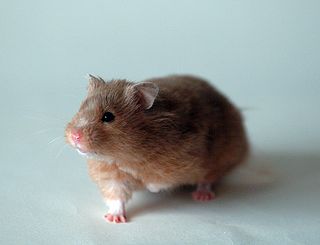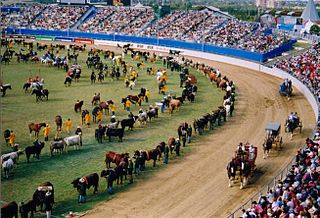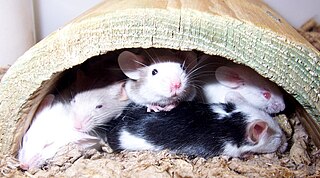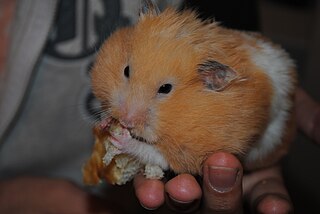
Gulf Hamstery was a hamstery which established the commercial Syrian hamster industry in the United States. [1] It operated between 1946 through the early 1950s and was located in Mobile, Alabama. [2]

Gulf Hamstery was a hamstery which established the commercial Syrian hamster industry in the United States. [1] It operated between 1946 through the early 1950s and was located in Mobile, Alabama. [2]

In 1946 Albert Marsh of Mobile, Alabama, won a hamster as payment for a $1 gambling debt. [2] This hamster came probably from the breeding stock managed by Guy Henry Faget in Carville, Louisiana. [3] [4] [2] [5] At the time, Marsh was a highway engineer but unemployed. [3] After getting his hamsters, he learned to breed them and founded Marsh Enterprises and the Gulf Hamstery, which promoted Syrian hamsters as pets, for laboratory use, and in business schemes. [3] Marsh took advertisements in magazines, comics, and livestock trade journals which praised hamsters as pets and presented the idea that breeding hamsters was a good business investment. [3] In his business, he shipped hamsters to people who would be breeders, then he coordinated the shipment of various breeders' hamsters to other breeders or to laboratories. [3]
Marsh was successful in part because of the professionalism he brought to the art of hamster husbandry. [6] In 1946, Marsh began a campaign to legalize the ownership of hamsters in California, where it was prohibited. [6] On 10 February 1948, with the help of the governor of Alabama and others, Marsh was successful in convincing the California State Department of Agriculture to designate Syrian hamsters as "normally domesticated animals". [6] Also by 1948 Gulf Hamstery employed 18 people including 5 office staff. [2] 1948 was the first publication of Marsh's book The Hamster Manual, which had a distribution of 80,000 copies by its 6th edition in 1951. [3] [7] In 1951 Gulf Hamstery generated US$200,000 in revenue. [2]
The hamstery business peaked from 1948–1951 then profitability dropped to almost nothing in the early 1950s. [8] The market changed when small hamsteries, most of which started with hamsters from Marsh, became available everywhere and satisfied local demand for pet hamsters. [8] Marsh's Gulf Hamstery closed in the 1950s. [8] Marsh later moved to California and operated a quail breedery. [8]
Various hamsteries were founded with hamsters from the Gulf Hamstery stock and by using The Hamster Manual as advice. [9] The two largest hamsteries founded in this way were Engle Laboratory Animals and the Lakeview Hamster Colony. [10]
In 1949, 14-year old Everett Engle founded Engle Laboratory Animals based on a Gulf Hamstery order for a male and two female hamsters along with the book. [9] Within two years Engle had a stable business selling hamsters to laboratories. [9] By his mid-twenties hamster husbandry was his full-time job, and his regular clients included Pfizer, Mead Johnson, Dow Chemical Company, and Eli Lilly and Company. [9] In 1961, John F. Kennedy thanked the Engle family for providing hamsters ("Billy" & "Debbie") to Caroline Kennedy. [11] By the 1970s Engle Laborary Animals was delivering 14,000 hamsters per week to laboratories. [11] In 1984 Harlan acquired Engle Laboratories. [11] As of 2009 Engle's three sons have continued their careers as animal breeders for Harlan. [11]
Steven Slater founded the Lakeview Hamster Colony. [11] At the time he was an employee of Owens-Illinois and living in New Jersey, and he founded the hamstery after refusing his employer's request that he move with his family to work in another location. [11] Slater's breeding stock of hamsters originated in the Gulf Hamstery. [11] Slater developed a hamster with a defined microbiota by raising it in a sterile environment, and he also introduced other innovations in laboratory hamster breeding. [10] In 1969 he sold Lakeview to Charles River Laboratories. [10]

Hamsters are rodents belonging to the subfamily Cricetinae, which contains 19 species classified in seven genera. They have become established as popular small pets. The best-known species of hamster is the golden or Syrian hamster, which is the type most commonly kept as pets. Other hamster species commonly kept as pets are the three species of dwarf hamster, Campbell's dwarf hamster, the winter white dwarf hamster and the Roborovski hamster.

The golden hamster or Syrian hamster is a rodent belonging to the hamster subfamily, Cricetinae. Their natural geographical range is limited to arid areas of Syria, Turkey and Greece. Their numbers have been declining in the wild due to a loss of habitat from agriculture and deliberate elimination by humans. Thus, wild golden hamsters are now considered vulnerable by the International Union for Conservation of Nature.

Israel Aharoni was a zoologist in Ottoman and British Palestine widely known as the "first Hebrew zoologist." Aharoni discovered 30 previously unknown species of animals, insects and birds, and is credited with giving them Hebrew names.

The Turkish hamster, Mesocricetus brandti, also referred to as Brandt's hamster, Azerbaijani hamster, or avurtlak, is a species of hamster native to Turkey, Armenia and other surrounding nations. The Turkish hamster, first catalogued in 1878, is a fairly close relative of the Syrian or golden hamster, though far less is known about it, and it is rarely kept as a pet. The population of the Turkish hamster is said to be declining in the wild, yet this hamster is often used in laboratory testing. Turkish hamsters have lifespans of about two years and are solitary, nocturnal animals, which practice hibernation. They are reported to be more aggressive than other members of the family Cricetidae. They are tan and dark, sandy brown in color. Like all hamsters, the Turkish hamster has cheek pouches that allow it to carry large amounts of food at one time.

The winter white dwarf hamster, also known as the Russian dwarf hamster, Djungarian hamster, striped dwarf hamster, Siberian hamster or Siberian dwarf hamster, is one of three species of hamster in the genus Phodopus. It is ball-shaped and typically half the size of the Syrian hamster, so is called a dwarf hamster along with all Phodopus species. Features of the Winter white hamster include a typically thick, dark grey dorsal stripe and furry feet. As winter approaches and the days shorten, the Winter white dwarf hamster's dark fur is almost entirely replaced with white fur. In captivity, this does not usually happen as animals maintained as pets are generally housed indoors and exposed to artificial light that prevents the recognition of short winter daylengths. In the wild, they originate from the wheat fields of Kazakhstan, the meadows of Mongolia, Siberia, and the birch stands of Manchuria.

An animal show is a form of exhibition featuring the display or performance of one or more breeds of animal.

Campbell's dwarf hamster is a species of hamster in the genus Phodopus. It was given its common name by Oldfield Thomas in honor of Charles William Campbell, who collected the first specimen in Mongolia on July 1, 1902. It is distinguished from the closely related Djungarian hamster as it has smaller ears and no dark fur on its crown. Campbell's dwarf hamster typically has a narrow dorsal stripe compared to the Djungarian hamster and grey fur on the stomach. This hamster may be raised in captivity and kept as a small pet.

The most common rodents kept as household pets are hamsters, gerbils, common degus, fancy mice, fancy rats, common chinchillas, and guinea pigs (cavies).

The Roborovski hamster, also known as the desert hamster or Robo dwarf hamster, is the smallest of three species of hamster in the genus Phodopus. It lives in the deserts of Central Asia, averaging under 2 centimetres (0.8 in) at birth and 4.5–5 centimetres (1.8–2.0 in) and 20–25 grams (0.71–0.88 oz) during adulthood. Distinguishing characteristics of the Roborovskis are eyebrow-like white spots and the lack of any dorsal stripe. The average lifespan for the Roborovski hamster is 2–3 years, though this is dependent on living conditions. Roborovskis are known for their speed and have been said to run up to 6 miles a night.

Hamster wheels or running wheel are exercise devices used primarily by hamsters and other rodents, but also by other cursorial animals when given the opportunity. Most of these devices consist of a runged or ridged wheel held on a stand by a single or pair of stub axles. Hamster wheels allow rodents to run even when their space is confined. The earliest dated use of the term "hamster wheel", located by the Oxford English Dictionary, is in a 1949 newspaper advertisement.

The fat-tailed gerbil, also called the duprasi gerbil, is a rodent belonging to subfamily Gerbillinae. It is the only member of the genus Pachyuromys. These rodents are the most docile species of the gerbil subfamily. They have fluffy and soft fur. Fat-tailed gerbils have been available on the pet market for decades, but in the 21st century breeders can be hard to find. They are sometimes considered as pocket pets.
Colours of the Syrian hamster can be described in three ways: as "self", "agouti" or "combinations". Self colours are a consistent coat colour with the same colour topcoat and undercoat. Agouti hamsters have a different, lighter undercoat and markings around the eyes. Combinations are produced when two self or agouti colours are present.

A hamster show is an event in which people gather hamsters to judge them against each other. Hamster shows are also places where people share their enthusiasm for hamsters among attendees. Hamster shows feature an exhibition of the hamsters participating in the judging.

A hamster cage is a cage designed to house hamsters.

The domestication of the Syrian hamster began in the late 1700s when naturalists cataloged the Syrian hamster, also known as Mesocricetus auratus or the golden hamster. In 1930 medical researchers captured Syrian hamster breeding stock for animal testing. Further domestication led this animal to become a popular pet.

Syrian hamster care includes all the actions which a person might take to promote animal welfare in the Syrian hamster when it lives with humans either as a pet or laboratory animal.

Syrian hamster breeding is selective breeding on Syrian hamsters. The practice of breeding requires an understanding of care for the Syrian hamster, knowledge about Syrian hamster variations, a plan selective breeding, scheduling of the female body cycle, and the ability to manage a colony of hamsters.
Syrian hamsters are one of several rodents used in animal testing. Syrian hamsters are used to model human medical conditions including various cancers, metabolic diseases, non-cancer respiratory diseases, cardiovascular diseases, infectious diseases, and general health concerns. In 2014, Syrian hamsters accounted for 14.6% of the total animal research participants in the United States covered by the Animal Welfare Act.
Billie and Debbie were Syrian hamsters who were United States presidential pets in the care of Caroline Kennedy during the presidency of her father John F. Kennedy. They joined the First Family at the White House in January 1961.

Jean Mill was a cat breeder and a conservationist who worked to protect the Asian leopard cat. Mill is best known as the founder of the modern Bengal cat breed: Mill successfully crossed the wild Asian leopard cat with a domestic cat, and then backcrossed the offspring through five generations to create the domestic Bengal. Mill made contributions in two other cat breeds: the Himalayan and the standardized version of the Egyptian Mau. Mill and her first husband, Robert Sugden, were involved in a precedent-setting case about the United States government's power to monitor short wave radio communications. She also authored two books.